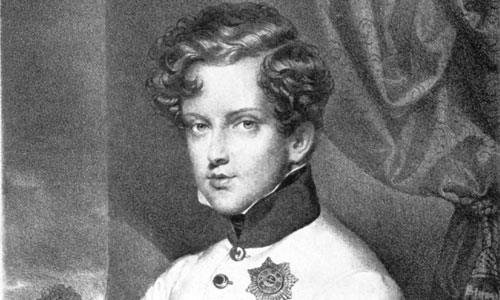L’Aiglon: A Reflection on Patriotism by Richard Turp
/ February 1, 2015
Version française...
In March, the Orchestre symphonique de Montréal will present a little-known work by Jacques Ibert and Arthur Honegger. Our collaborator Richard Turp tells us about the historic context of its creation.

In 1900 Edmond Rostand wrote a play entitled L’Aiglon, featuring Sarah Bernhardt, based on the life of the Duke of Reichstadt, Napoleon Bonaparte’s son. Following his father’s death, the young man became a virtual prisoner of Chancellor Metternich at the Hapsburg court in Austria. In 1832, the young Duke died from tuberculosis at the age of twenty-one. ‘My birth and my death, that is my story. Between the crib and the tomb there is a huge nothing’ is how he described his own life. In 1852, Victor Hugo wrote a poem, Napoléon II, in which he called the Duke ‘aiglon’ or eaglet (his father being the Eagle).
Rostand described his play as being simply ‘the story of a poor child.’ This is only partly true. His play was created in March 1900, a time when France was in the midst of the so-called Dreyfus affair and was threatened by the belligerent new German Empire. Jacques Ibert and Arthur Honegger’s opera, L’Aiglon was composed two years before World War II. In both cases, France realised it was on the cusp of a world conflict, with a hostile, warmongering Germany.
France needed to rearm itself both materially and morally, and artistic creators mobilised themselves. Honegger and Paul Claudel created Jeanne d’Arc au bûcher; film director Carl Dreyer produced the Passion de Jeanne d’Arc, while fellow director, Abel Gance produced his 1927 masterpiece, Napoléon (for which Honegger composed the music). Rostand’s play is obviously a personal drama but it is also a reflection on patriotism, honour, manipulation and morality. With L’Aiglon, Honegger and Ibert adroitly use the past as a means to illuminate the future.
L’Aiglon is one of the few operas written jointly by two composers. In 1936, the director of the Opéra de Monte-Carlo, Raoul Gunsbourg wanted to present an opera based on Rostand’s play. The choice of the composer was a difficult one but two names stood out : Jacques Ibert and Arthur Honegger. The two composers were friends, and they ultimately decided to collaborate on the score.
Ibert described their decision in these terms: ‘It was a car incident that prompted Honegger and I to collaborate (….). The Rostands and (librettist) Henri Cain had enquired if I would be interested in composing the score for L’Aiglon. They had also thought of Honegger. Both of us hesitated. Destiny decided that one day, when Honegger was with me, my car broke down on the roadside. L’Aiglon appeared as a topic of conversation and so our collaboration was born.’
In a 1937 article in Figaro, Honegger explained the work’s challenges and mandate: ‘Our work has an undeniable originality; that of bringing together on the same musical collaboration, two composers of the same generation (…) The determining factor of this collaboration was a mutual desire to try and create a work with a popular and direct character.’ Having completed the project, Honegger added: ‘The secret of our collaboration? There is none. One wrote the sharps and the other the flats!’
In reality, artistic choices were dictated by the composers’ respective personalities: Ibert wrote acts I and V, in which finesse, emotion and restraint predominate while Honegger took on acts II and IV, with their drama and heroism. The third act was composed jointly. The resulting work is intense and moving. The major challenge was to maintain a musical balance while constantly sustaining the dramatic progression so dear to Honegger’s heart and also communicating the elegance and subtlety of Ibert’s writing. The fourth act in particular contains an epic sweep and great dramatic tension (in a dream, the protagonist, surrounded by an army of ghosts, relives the battle of Wagram). The final act, in which the dying hero is serenaded by a series of popular French songs, is imbued with emotion.
This jointly conceived work depicts an Aiglon whose ‘clothes are too large for the young man….’ And so, just as in the play, a woman interprets the title role. Despite its five-act form, L’Aiglon lasts barely two hours and proceeds at breakneck pace. In fact, the work deploys an exceptional, efficient dramatic structure. Not only have Honegger and Ibert succeeded in retaining their individual musical personalities, but they have also done so without compromising the homogeneity of the complete work. The triumphant premiere of L’Aiglon took place on March 10, 1937, at l’Opéra de Monte-Carlo with a star-studded cast that included the soprano Fanny Heldy as L’Aiglon, the bass-baritone Vanni-Marcoux as Séraphin Flambeau and the baritone Arthur Endrèze as Metternich.
The OSM presents the work three times (March 17, 19 and 21) with two European artists in the featured roles, namely the Belgian soprano, Anne-Catherine Gillet and the French baritone, Marc Barrard. They are supported by an impressive array of leading Canadian singers including Étienne Dupuis (as Metternich), Philippe Sly, Marianne Fiset, Tyler Duncan, Julie Bouliane, Michèle Losier and Pascal Charbonneau, all under the direction of Kent Nagano. The OSM is offering a 15% discount to LSM readers for the concert using the promo code “Scena”. Take advantage of this offer today! www.osm.ca
Version française... | |

